In platform terms, Israel’s Gaza campaign has just moved from “urban edge” operations into “dense-core” operations—a shift that fundamentally changes the load on the system. The new plan includes fighting in Gaza’s central refugee camps, areas that are not only geographically tighter but also socially and politically more entangled. Think of it like a delivery platform deciding to operate in alleyway micro-markets instead of sticking to main-street hubs: the potential reach is greater, but the transaction costs, error margins, and political blowback spike.
For months, Israel’s operational model in Gaza leaned on a mix of targeted raids, perimeter control, and selective pressure on high-value zones. That structure allowed for resource concentration, faster redeployments, and a predictable logistics loop. By moving into the central refugee camps—Nuseirat, Al-Bureij, Maghazi—Israel is effectively pivoting from a perimeter-based operating system to a deep-insertion model. In founder terms, it’s like switching from B2B to direct-to-consumer overnight: suddenly the distribution logic, cost base, and exposure profile all change.
The underlying tension here is that dense-core fighting doesn’t scale the way edge control does. Every block in a refugee camp is more like a nested marketplace—crowded, hard to map, and resistant to one-size-fits-all enforcement. That means Israel’s tactical “unit economics” shift: each objective takes more manpower, each sweep burns more political capital, and each misstep has a compounding effect on both security and international perception. The operating cost per “secured” zone rises while the net strategic retention—the ability to hold ground without constant reinvestment—often drops.
If you look at past campaigns, whether Fallujah in 2004 or Mosul in 2016, deep-core offensives required a re-architecture of logistics and intel loops. You can’t just push the same patrol cadence or intel feed from a perimeter model into this environment—it creates latency, misses context, and risks overextension. For Israel, that means more embedded units, heavier reliance on real-time data, and tighter integration between kinetic and civil-administrative operations. It’s like a SaaS platform realizing that its onboarding flow has to change entirely once it targets a different user persona: same product shell, different engagement logic.
The shift also exposes incentive misalignment between the “ops” and “narrative” sides of the campaign. From a pure operational lens, taking control of central camps could fragment Hamas command nodes and disrupt smuggling or tunnel networks. From a diplomatic and media standpoint, it escalates civilian risk in areas where population density is among the highest in Gaza. In platform economics, this is the equivalent of pushing aggressive monetization features that boost ARPU in the short term but risk long-term churn from your most visible user segments.
Other actors in the ecosystem—regional mediators, aid agencies, even rival militant factions—will recalibrate around this change. For humanitarian operations, the model shift makes aid delivery less predictable, pushing more actors into high-risk negotiation channels. For Hamas, the dense-core fight may be leveraged as an asymmetry advantage, exploiting the very complexity and cost structure that makes it harder for a conventional military to sustain momentum. And for Israel’s own domestic front, this reallocation of military focus could stretch readiness in other theatres, from the northern border to West Bank flashpoints.
Comparisons to “healthier systems” in this context are messy but useful. In counterinsurgency models that aimed to integrate control with local governance—like the US surge strategy in certain Baghdad neighborhoods—the key was not just the kinetic sweep but the immediate follow-up with services, security integration, and trust-building. Without that, the reclaimed space had a high relapse rate into instability, essentially wiping out the gains from the initial push. In founder terms, it’s churn: you can acquire users through a costly promo campaign, but if your retention mechanisms aren’t in place, the CAC never pays back.
The timing of this shift also matters. In the lifecycle of a long conflict, operational pivots into more complex terrain can either signal confidence—pushing to close capability gaps before adversaries regroup—or necessity, driven by diminishing returns from existing methods. The messaging from Israeli leadership frames it as the former, but the resource intensiveness and parallel threats suggest the latter is at least in play. It’s like a startup claiming its expansion into a new vertical is about “capturing growth,” when in reality the core product’s engagement metrics are plateauing.
For founders and operators looking at this as a case study in model adaptation, the takeaway is clear: moving into a more complex market segment requires more than just more effort—it requires a rebuild of the entire execution framework. You can’t just port the existing playbook; you have to re-engineer the supply chain, the data loops, and the incentive structures so the system doesn’t collapse under its own new costs.
This isn’t just a battlefield escalation—it’s a model pivot with baked-in fragility. The operational math gets harder, the margin for error narrows, and the sustainability of the gains becomes the real metric. In platform terms, it’s like moving from a profitable, predictable customer base into one with higher potential but negative margins unless you fundamentally change the way you operate. Without that shift in operating logic, the strategy risks becoming a high-burn growth play that never actually converts.















